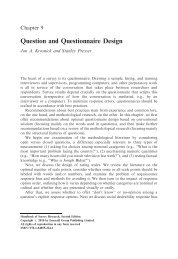Four Strategies for the Age of Smart Services - Courses
Four Strategies for the Age of Smart Services - Courses
Four Strategies for the Age of Smart Services - Courses
You also want an ePaper? Increase the reach of your titles
YUMPU automatically turns print PDFs into web optimized ePapers that Google loves.
7 <strong>of</strong> 8<br />
• Replenishment and Commerce.<br />
Replenishment and commerce applications monitor consumption <strong>of</strong> a device and buying patterns <strong>of</strong> <strong>the</strong> end user. These applications can initiate<br />
purchase orders or o<strong>the</strong>r transactions when replenishment is needed.<br />
• Location Mapping and Logistics.<br />
Location mapping and logistics applications track and optimize <strong>the</strong> service support system <strong>for</strong> a device. These applications also support supply<br />
chain and sales activities.<br />
The Product Life Cycle from a Customer’s Perspective<br />
One company we worked with identified <strong>the</strong> following activities involved in owning and using one <strong>of</strong> its products. The question <strong>the</strong>n became, “Which <strong>of</strong><br />
<strong>the</strong>se activities represent opportunities”<br />
• Determining requirements and justifying purchase <strong>of</strong> <strong>the</strong> product<br />
• Finding a product supplier<br />
• Financing <strong>the</strong> purchase<br />
• Installing <strong>the</strong> product<br />
• Modifying o<strong>the</strong>r products or processes to work with <strong>the</strong> product<br />
• Adapting <strong>the</strong> product to its environment or to a specific use<br />
• Maintaining <strong>the</strong> product and replacing parts<br />
• Replenishing materials (<strong>for</strong> instance, paper and toner <strong>for</strong> a copier)<br />
• Training personnel to use <strong>the</strong> product<br />
• Using <strong>the</strong> product<br />
• Upgrading <strong>the</strong> product<br />
• Disposing <strong>of</strong> product waste<br />
• Disposing <strong>of</strong> <strong>the</strong> product<br />
How <strong>Smart</strong> Do You Want Your Products to Be<br />
Obviously, not all devices and subsystems need to be networked. Consider, <strong>for</strong> example, <strong>the</strong> difference in value between networking a refrigerator in a<br />
small <strong>of</strong>fice and networking a refrigeration system in a grocery store, where failure would have much greater consequences. In <strong>the</strong> latter case, a<br />
one-night shutdown could cost <strong>the</strong> store a year’s pr<strong>of</strong>its, so <strong>the</strong> up-front cost <strong>of</strong> networking is an obvious investment. The decision to network a<br />
product will depend largely on how that product will be used and <strong>the</strong> potential role it can play in a larger system.<br />
In general, a device is not a candidate <strong>for</strong> networking if it:<br />
• Is not mechanical or electromechanical<br />
• Is very simple or inexpensive and thus not worth <strong>the</strong> initial investment <strong>of</strong> networking<br />
• Has no important in<strong>for</strong>mation to share<br />
• Has no available or reliable network access<br />
• Has a very brief or very long (15-year-plus) life span<br />
The benefits <strong>of</strong> networking depend on <strong>the</strong> context, but <strong>the</strong>re are some important issues to consider when deciding what to network:<br />
• The Impact <strong>of</strong> a Device Failure.<br />
Not every failure is catastro-phic. If a keyboard breaks in a food-processing plant, production won’t stop. The failure will be confined to one specific<br />
computer, and <strong>the</strong> keyboard can be easily and cheaply replaced. But if <strong>the</strong> plant’s power system suddenly stops working, <strong>the</strong> end result could be<br />
vast amounts <strong>of</strong> wasted products and employee time.<br />
• The Value <strong>of</strong> Device In<strong>for</strong>mation.<br />
A scanner at a department store is a good candidate <strong>for</strong> networking because <strong>the</strong> data it collects can in<strong>for</strong>m many decisions related to customers’<br />
buying behaviors. Connectivity will deepen <strong>the</strong> manufacturer’s insight into purchasing patterns, inventory, procurement, and product or store<br />
designs.
















